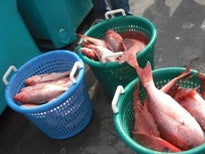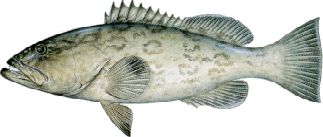 When the largest paper in Texas (.42 million readers) puts catch shares on its front page, you know it’s worth talking about. This Saturday the Houston Chronicle wrote an article titled “Catch and Relief: A new share system for fishing red snapper in the Gulf appears to benefit anglers, as well as the species suffering from overfishing.”
When the largest paper in Texas (.42 million readers) puts catch shares on its front page, you know it’s worth talking about. This Saturday the Houston Chronicle wrote an article titled “Catch and Relief: A new share system for fishing red snapper in the Gulf appears to benefit anglers, as well as the species suffering from overfishing.”
The story features commercial fisherman Buddy Guindon, who also owns Katie’s Seafood in Galveston, TX. He owns quota in the Gulf of Mexico’s commercial red snapper individual fishing quota (IFQ) program, a type of catch share.
An interesting excerpt:
“At first, the concept of individual shares so worried Guindon that he sold one of his two seafood markets as a pre-emptive move. Two years later, Guindon said he is catch half the fish but making more money. The new system allows him to reduce expenses because his boats can take longer and more fuel-efficient trips while increasing revenue by fishing when the Gulf is safe and dockside prices are high.”
Check out the full story.










 This morning the National Oceanic and Atmospheric Administration (NOAA) made one of the most significant decisions in the name of saving Gulf of Mexico fisheries, fishermen, and coastal fishing communities by
This morning the National Oceanic and Atmospheric Administration (NOAA) made one of the most significant decisions in the name of saving Gulf of Mexico fisheries, fishermen, and coastal fishing communities by  the water and at the docks.
the water and at the docks. Gulf of Mexico fisheries regulators recently closed down longline fishing (7-9 mile fishing lines with hundreds of hooks) in the Gulf of Mexico off west Florida for six months because the government reported that more threatened sea turtles were being caught than expected. The result of the closure is that turtles will be saved, but jobs will be lost.
Gulf of Mexico fisheries regulators recently closed down longline fishing (7-9 mile fishing lines with hundreds of hooks) in the Gulf of Mexico off west Florida for six months because the government reported that more threatened sea turtles were being caught than expected. The result of the closure is that turtles will be saved, but jobs will be lost. In the midst of all this, our very own Dave McKinney came up with a solution to save turtles and jobs. We’ve started a grant program that provides financial assistance to longline fishermen who convert to vertical gear, which causes far fewer turtle interactions. We have already received almost 30 applications and the new gear has already been put on more than five vessels.
In the midst of all this, our very own Dave McKinney came up with a solution to save turtles and jobs. We’ve started a grant program that provides financial assistance to longline fishermen who convert to vertical gear, which causes far fewer turtle interactions. We have already received almost 30 applications and the new gear has already been put on more than five vessels.